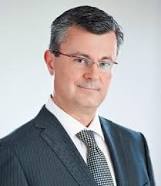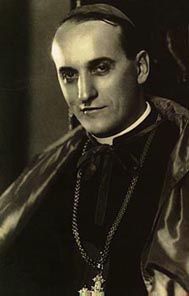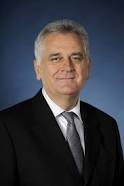April 7, 2016, Thursday — The Problem, and the Opportunity, of the Stepinac Case
Croatian Prime Minister Meets Pope Francis

The meeting took place this morning. (link)
Reports prior to the meeting said that among the subjects of his talks with Francis would be the refugee situation in Croatia and also the proposed canonization by the Catholic Church of Croatian Cardinal Alojzije Stepinac (1898-1960), the Archbishop of Zagreb from 1937 to 1960.
Stepinac (photo below) is considered a courageous religious leader and martyr by Croatian Catholics. He was imprisoned for years by the Communist Yuguslav regime after the end of the Second World War.

Pope John Paul II declared Stepinac blessed in 1998.
Still, “Stepinac remains a hotly disputed figure in former Yugoslavia,” Milekic writes, “revered by Catholic Croats and widely detested among Serbs.”
In this situation of tension over Stepinac and his canonization cause, the Holy See has done something extraordinary: it has set up a “joint commission” which includes Serbian Orthodox in order to study the matter.
Essentially, this means that Pope Francis has decided to “slow down” the Stepinac case for a moment before making any decision on canonizing the revered Croatian Catholic leader out of respect for the feelings and concerns of the Serbian Orthodox.
To do this, Francis is giving the Orthodox a chance to have their voices heard inside an ongoing Catholic canonization process.
This is unprecedented.
But it offers insight into the mind and intent of Pope Francis: he clearly wishes to bring closer unity with the Orthodox, and he is willing to do unprecedented things to take steps toward that unity.
This was the meaning of his decision meet with Russian Orthodox Patriarch Kirill in Havana, Cuba, on February 12, and this is the meaning of his decision to create this special commission including Serbian Orthodox members to study the Stepinac case.
Croatian government sources are saying that “Pope Francis is not questioning whether Stepinac lived a holy life, but the process has been prolonged because the Pope wants to convince representatives of the Orthodox Church.” (link)
In an article published in January by the Osservatore Romano, the Vatican’s semi-official daily paper, Father Hyacinthe Destivelle, an official in the Vatican’s Council for the Promotion of Christian Unity, noted that Stepinac is a sensitive issue for the Pope at a moment when he is seeking to improve relations with the Orthodox Church generally.

Nikolic said he had told Francis that Stepinac “played a really bad role during World War 2,” remaining silent while people “were killed only because they weren’t Catholics.”
“Many Catholics in Croatia are equally passionate about Stepinac, however,” Milekic writes, “seeing him as a heroic figure who resisted the imposition of Communism and remained with his flock in Croatia after the Communist takeover when he could have fled abroad. He died under house arrest following several years in prison. His supporters also note that attacks on him for his wartime role only really started after he publicly opposed the imposition of communist rule in Yugoslavia. After his trial before a Yugoslav court in 1946, he was jailed for 16 years for collaboration with the Ustase and the Axis occupying forces. He was released to house arrest after five years and died in 1960 of thrombosis.”
After his meeting with Pope Francis, the Croatian Prime Minister met with Secretary of State of the Holy See Pietro Parolin to discuss the contracts between Croatia and the Vatican, as well as the issue of restitution of, or compensation for, confiscated and nationalized Church property.
The Prime Minister was accompanied by his wife, two daughters and two sons.
Special note: This summer will will travel to Moscow, Kiev, Istanbul and Rome from July 8 to 18 on our Urbi et Orbi Foundation pilgrimage. If you would like to join the Foundation and participate in and support our work, or, if you would like more information on this pilgrimage, please email [email protected], and we will send you further information. The pilgrimage is limited to 10 people.
The Urbi et Orbi Foundation: The purpose of the Urbi et Orbi Foundation is to build bridges of trust and understanding to enable the possibility of greater Church unity, without seeking to minimize or overlook the important theological and doctrinal issues that continue to impede this unity. We hope to assist in the implementation of the February 12 common declaration of Havana, Cuba, by Pope Francis and Patriarch Kirill, and in so doing to fulfill the vision of Pope John Paul II of a Church which “breathes with two lungs,” in keeping with the final prayer of Jesus, that those who were his disciples “might all be one” in unity of faith and doctrine.
Note: These newsflashes go to some 20,000 people around the world. If you would like to subscribe, simply send me an email address, and I will add you to the list. Also, if you would like to subscribe to our print magazine, Inside the Vatican, please do so! It would support the old technology of print and paper, as well as this newsflash. Click here.
What is the glory of God?
“The glory of God is man alive; but the life of man is the vision of God.” —St. Irenaeus of Lyons, in the territory of France, in his great work Against All Heresies, written c. 180 A.D.







Facebook Comments